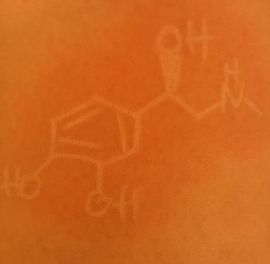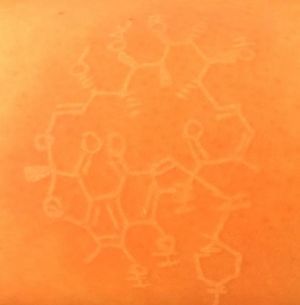Article
Pharmacy Professor Uses Her Skin to Teach Students
Author(s):
A pharmacy professor is using her unique skin condition to teach students about drug molecules.

A pharmacy professor is using her unique skin condition to teach students about drug molecules.
Zoë A. E. Waller, PhD, a professor of chemical biology in the University of East Anglia (UEA) School of Pharmacy in England, discovered she had dermatographia urticarial a few years ago.
When Dr. Waller lightly scratches her skin, a raised wheal similar to hives temporarily appears. The condition is generally harmless, and many of those with dermatographia do not seek treatment for it, according to the Mayo Clinic.
A colleague introduced Dr. Waller to an artist named Ariana Russell, who used her dermatographia to create art on her skin.
“I loved what she did,” Dr. Waller told Pharmacy Times. “It involved no extra art supplies and was unusual as it was only temporary.”
Russell’s work inspired the pharmacy professor to draw molecules on her skin as a teaching tool for her students. She uses a wooden skewer, which allows her to draw greater detail for some of the larger molecules, such as vancomycin or oxytocin. The skewer is “sharp enough to get the detail, but not so sharp that it actually breaks the skin,” she explained.
Her skin drawings of molecules also draw inspiration from UEA School of Pharmacy professor David Wright, who created a “top trumps” drug game aimed to provide students with a working knowledge of the most common drugs they will encounter as pharmacists. Dr. Waller used these top 100 drugs cards in her medicinal chemistry classes and started drawing the drug molecules on her skin as an interesting way to grab her students’ attention.
Dr. Waller said her students did not seem surprised when she started the project, as the pharmacy school embraces a culture of diversity in its teaching. Some students actually made requests for their favorite drug molecules, she said.
“I’m always trying something different in my teaching,” Dr Waller told Pharmacy Times. “The point is really to be a reminder—every day a new molecule and what it does. I post them in the public domain so they are accessible to anyone who is interested.”

Using the Twitter handle @InnocentWal, Dr. Waller tweets a photo of her skin and the drug of the day. A recent tweet explained the day’s drawing was rifampicin, a bactericidal antibiotic drug often used to treat tuberculosis.
Dr. Waller said Twitter allows her to stay up to date on leading research as it happens. She also said it is a great place for pharmacists to share ideas and news. Social media in general also provides pharmacists an outlet to show both their professional side and the personality behind that profession.
“I understand, particularly when I give talks in schools, that I could be a role model for budding pharmacists and scientists,” she said. “I always say, ‘If you have any questions, my contact details are online,’ but, for example, Twitter is far less formal than sending someone an email or phoning them up.”
With her first degree in chemistry with pharmaceutical and forensic science, and a deep love of the intersection of chemistry and biology, Dr. Waller feels at home teaching within the UEA School of Pharmacy. Her school, students, and staff are open to non-traditional teaching methods, so a professor who goes out of the box—and onto her skin—is more than welcome.
Newsletter
Stay informed on drug updates, treatment guidelines, and pharmacy practice trends—subscribe to Pharmacy Times for weekly clinical insights.





